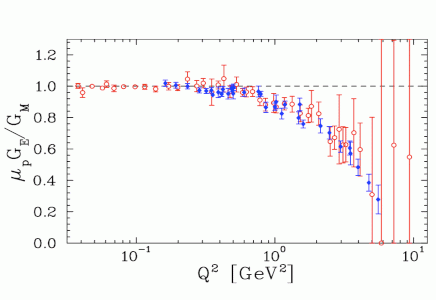Two-Photon Exchange in Elastic Electron-Proton Scattering

Ratio μp GEp/GMp extracted from polarization transfer (blue filled diamonds) and Rosenbluth separations (red open circles) including two-photon exchange corrections.
Additional Links
The ratio of the electric to magnetic proton form factors has traditionally been determined using the "Rosenbluth" or longitudinal-transverse (LT) separation method, in which the ratio is extracted from the angular dependence of the cross section at fixed momentum transfer, Q2. Recent measurements at JLab using the alternative, polarization transfer (PT) technique have found a dramatically different behavior of the ratio compared with the Rosenbluth results, leading to much discussion about the possible origin of the discrepancy.
In a series of recent papers, JLab Theory Center staff and users have analyzed in detail the effects of two-photon exchange (TPE) in elastic ep scattering. In particular, contributions from elastic and excited nucleon intermediate states have been found to have a strong angular dependence when the finite size of the nucleon is taken into account, largely reconciling the LT and PT measurements. A complementary approach, in which the TPE contributions have been calculated at the partonic level in terms of generalized parton distributions, was also found to reduce the Rosenbluth cross sections, bringing them closer to the PT results.
The TPE calculations have subsequently been used in a global reanalysis of all elastic ep data, with corrected values of the proton's electric and magnetic form factors extracted over the full Q2range of the existing data. The analysis combined the corrected Rosenbluth cross section and PT data and was the first extraction of GEp and GMp including explicit TPE corrections and their associated uncertainties.
References:
P. G. Blunden, W. Melnitchouk, and J. A. Tjon, Phys. Rev. C 72 (2005) 034612
A.V. Afanasev, S.J. Brodsky, C.E. Carlson, Y.C. Chen and M. Vanderhaeghen, Phys. Rev. D 72 (2005) 013008
J. Arrington, W. Melnitchouk and J.A. Tjon, Phys. Rev. C 76 (2007) 035205

